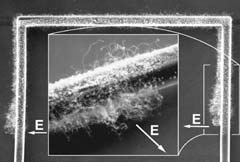This area deals with the fundamental laws and building blocks of nature and how they interact, the properties and the behavior of matter, and research into space and time and their structures.
innovations-report provides in-depth reports and articles on subjects such as astrophysics, laser technologies, nuclear, quantum, particle and solid-state physics, nanotechnologies, planetary research and findings (Mars, Venus) and developments related to the Hubble Telescope.

A material used to protect submarines from sonar detection is the latest technological breakthrough in ensuring the safe and effective dose of ultrasound in medicine. Practitioners and thousands of patients in physiotherapy departments worldwide will benefit from the latest technology, which will ensure a step forward in the reliability of delivered ultrasound treatment.
The material forms a key component in a novel desk-top ultrasound power meter developed by the UK’s national standards lab

An international team of astronomers have used a unique instrument on the 8-m Gemini South Telescope to determine the ages of stars across the central region of the barred spiral galaxy, M83. Preliminary results provide the first hints of a domino model of star formation where star formation occurs in a time sequence, driven by the movements of gas and stars in the central bar.
The new instrument, called CIRPASS, simultaneously produces 500 spectra, taken from across the whole region of inte

A light bulb isn’t very useful without a reliable on/off switch. The same holds true for quantum dots. These ultra tiny electronic nanostructures someday may serve as the ones and zeros used by a superfast quantum computer, but first physicists need to refine their ability to turn quantum dots “on” and “off.”
In the June 23, 2003, on-line issue of Applied Physics Letters, researchers from the National Institute of Standards and Technology (NIST) and the National Renewal Energy Laborato

Engineers at the University of California, Berkeley, have found an innovative way to grow silicon nanowires and carbon nanotubes directly on microstructures in a room temperature chamber, opening the doors to cheaper and faster commercialization of a myriad of nanotechnology-based devices.
The researchers were able to precisely localize the extreme heat necessary for nanowire and nanotube growth, protecting the sensitive microelectronics – which remained at room temperature – just a few mic

The Northern Lights are a visible result of physical processes in inner space. By studying the optical signal from the Northern Lights and similar phenomena, we can gain new knowledge about the physics behind them. In the long run such pure research may be of great importance for applications in our future supply of energy and for future space travel.
A dissertation at Umeå University, Sweden, by researcher Urban Brändström at The Swedish Institute of Space Physics, focuses on the constructi

Dutch physicists from Leiden University have made an experimental laser that combines the advantages of two types of laser. With the experimental laser, which generates light in a sort of billiards table with round edges, the researchers have demonstrated that is possible to produce cheaper lasers.
A conventional laser reflects light between two very accurately positioned mirrors, the so-called resonant cavity. The distance between the mirrors determines which wavelength is amplified and th